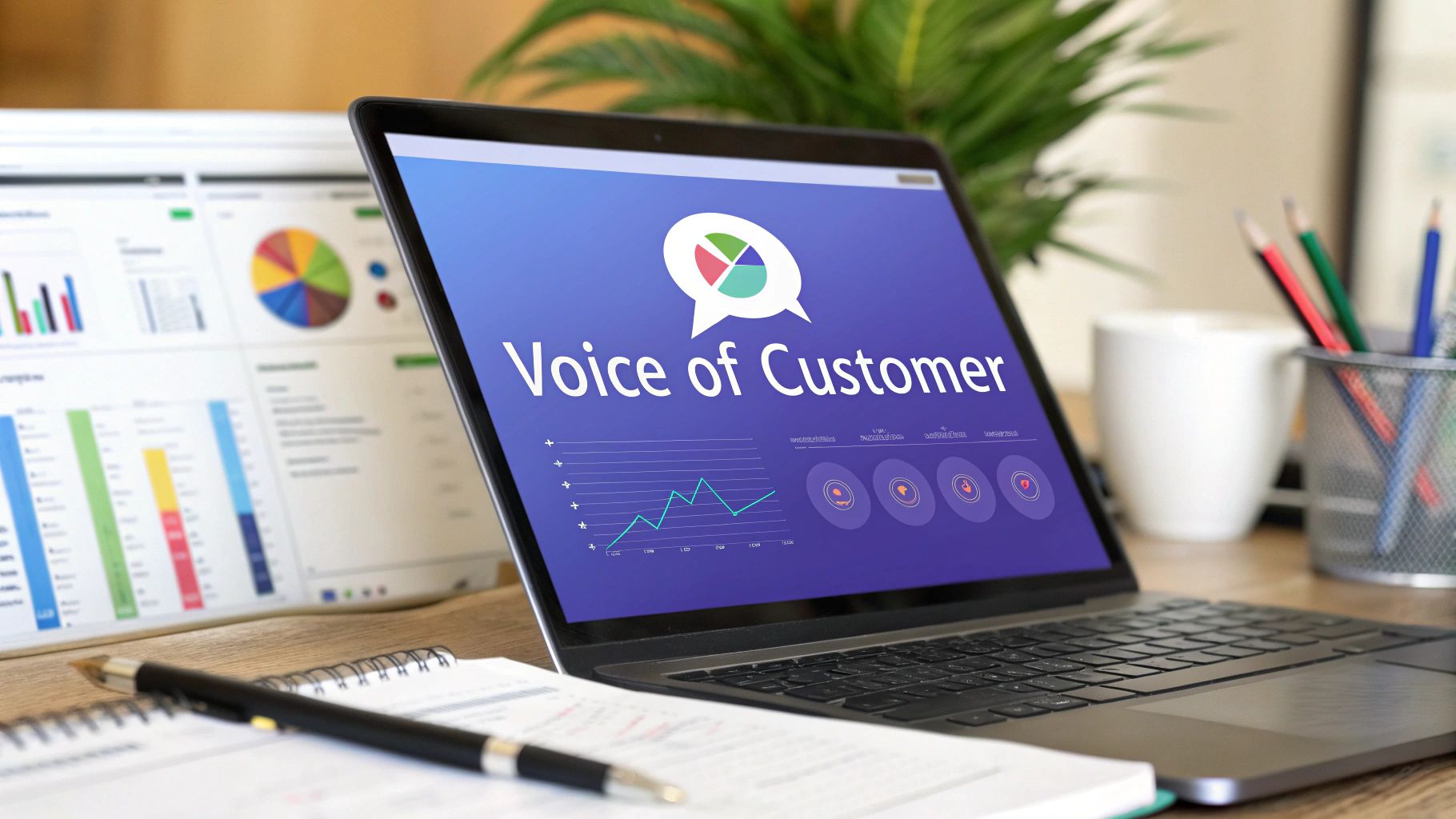Optimize Customer Experience with AI in SaaS
Learn how to optimize customer experience in your SaaS business. This guide offers actionable AI strategies for transformative results and sustained growth.
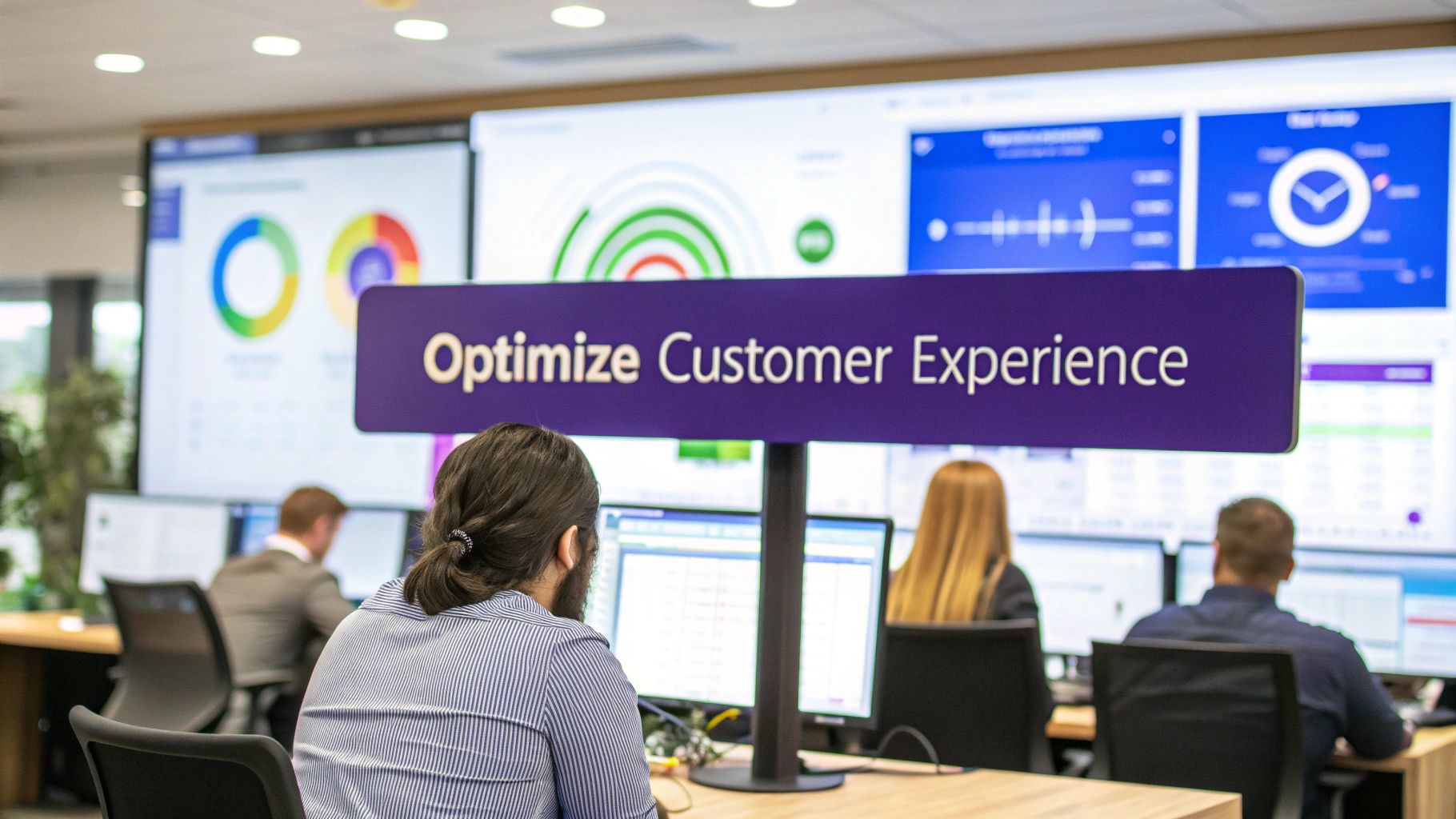
In a packed SaaS market, killer features and a low price tag just don't cut it anymore. If you really want to win, you have to nail the customer experience. It’s become the main battleground for keeping customers, growing your business, and building an advantage that actually lasts. This means ditching reactive support and moving to smart, proactive engagement that turns happy users into your biggest fans.
Why Customer Experience Is Your New Competitive Edge
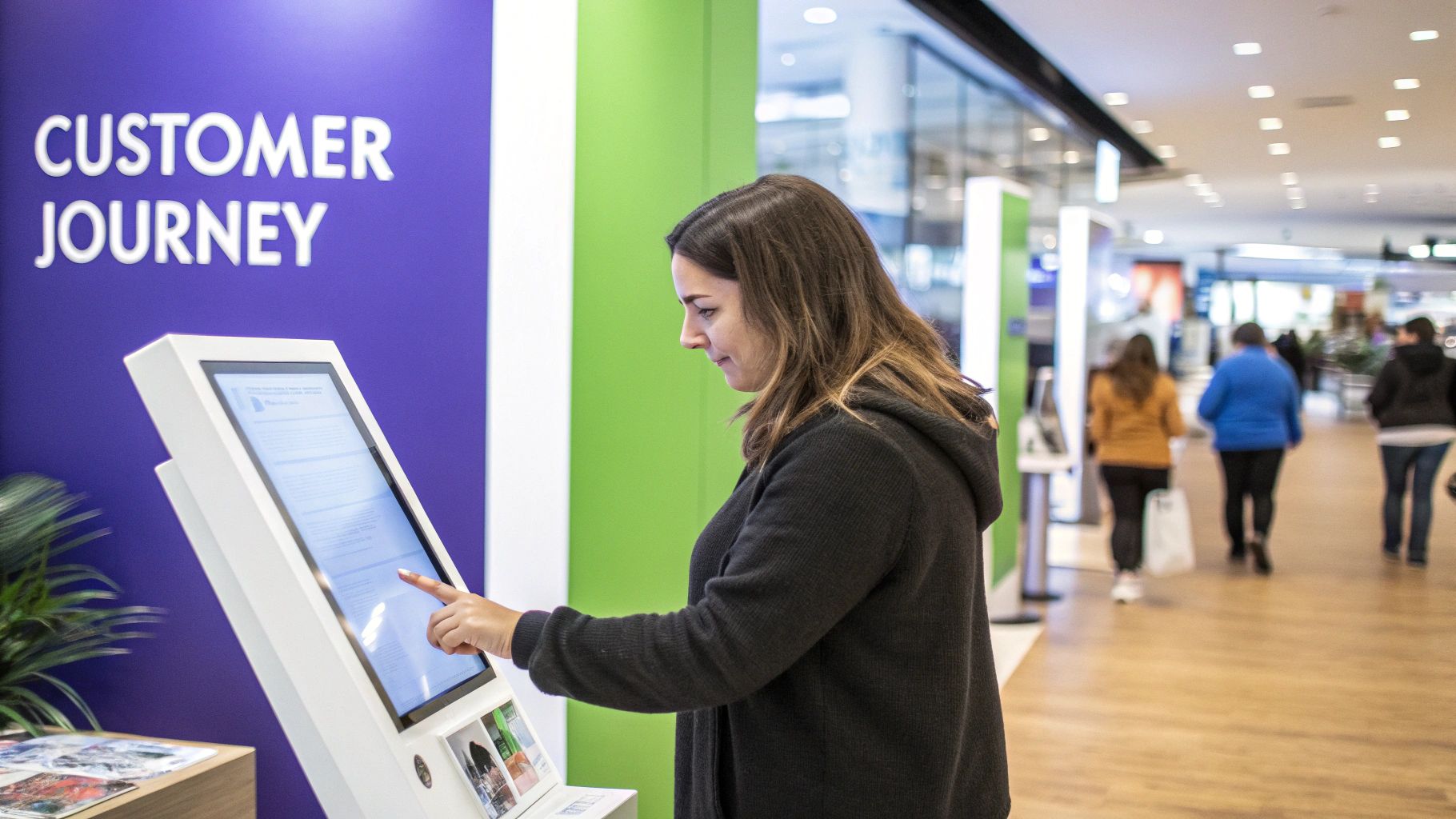
The SaaS game has changed. A few years ago, the company with the longest feature list or the cheapest plan often walked away with the deal. Today, that’s just the cost of entry. The real difference-maker is how customers feel when they use your product and interact with your brand.
This isn't just a hunch; it's a massive market shift. Customer experience (CX) has quickly become the deciding factor, blowing past old-school metrics like product features and pricing. It's a big deal.
Consider this: an overwhelming 89% of businesses expect to compete primarily on the experience they deliver. And it's not one-sided—80% of customers now say the experience a company provides is just as important as its products. The trend is undeniable.
Key Pillars of a Modern SaaS Customer Experience Strategy
To really get a handle on this shift, it helps to see how the old way of thinking stacks up against a modern, CX-focused approach. The table below breaks down the foundational pillars that separate the companies that get it from those that are still stuck in the past.
This table isn't just a list of buzzwords. It represents a fundamental change in mindset—moving from a company that simply sells software to one that partners in its customers' success. This is what it takes to build a truly durable business today.
The Move From Reactive Support to Proactive Engagement
For way too long, "customer service" just meant "solving problems." A user hits a snag, they file a ticket, and the support team reacts. That model is broken. It forces the customer to do all the work of finding friction and asking for help, usually after they're already frustrated.
Today's winning SaaS companies have completely flipped that script. They don't wait for the fire alarm; they're busy installing smoke detectors. This proactive approach looks a lot like this:
- Anticipating Needs: They use data to see how people are using the product and predict where they might get stuck.
- Intelligent Onboarding: Instead of a generic tour, they guide new users to the features that will help them hit their specific goals.
- Proactive Check-ins: They reach out to users who show signs of drifting away before they even think about churning.
- AI-Powered Assistance: They use tools like Surva.ai to automatically gather feedback and offer real-time solutions—like a discount or a plan pause—the moment a user hints at being unhappy.
A proactive strategy doesn't just solve problems faster—it often prevents them from happening in the first place. This builds incredible trust and shows customers you care about their success, not just their subscription payment.
The Tangible Business Impact
Let's be clear: focusing on CX isn't just about warm, fuzzy feelings. It's a straight-up engine for business growth. When you get the customer experience right, you directly impact your bottom line. Companies that are great at this see higher customer satisfaction, which directly leads to lower churn and more revenue.
It's a sustainable way to build a loyal customer base that not only sticks with you but also shouts your name from the rooftops. Understanding its significant Customer Experience ROI proves this isn't a "nice-to-have"—it's your new competitive edge.
Mapping The SaaS Customer Journey For Actionable Insights
You can't fix the customer experience if you don't actually understand it from their perspective. It’s about seeing your SaaS product not as you intended it to be used, but how people really use it—glitches, frustrations, and all. This means ditching the generic templates and getting your hands dirty mapping the actual path users take, from their first flicker of curiosity to becoming die-hard fans.
Think of a customer journey map as your strategic blueprint. It visually lays out every single interaction a customer has with your company. This isn't just about what they do inside your app; it's the whole shebang.
- Discovery: How did they find you in the first place? Was it a blog post, a social media ad, or a good old-fashioned recommendation?
- Consideration: What content did they look at before signing up? Did they watch a demo, pour over case studies, or size you up against competitors?
- Onboarding: What was that first-run experience like? Did they get that "aha!" moment quickly, or did they get stuck and bail?
- Adoption & Retention: How are they using the product day-to-day? Where do they see the most value, and where does friction start to creep in?
- Advocacy: What finally pushes a user to leave a glowing review or tell a colleague about you?
By charting these stages, you stop guessing. You start seeing the exact moments where users either fall in love with your product or quietly decide to churn.
Blending Data with Human Stories
The most powerful journey maps aren't built on assumptions. They’re a potent mix of two things: quantitative data and qualitative insights. You absolutely need both to see the full picture.
Quantitative data gives you the "what." This is the hard evidence you pull from your analytics tools. You're looking for patterns in metrics like:
- Drop-off rates during the onboarding flow.
- Feature adoption percentages for your latest releases.
- Time-to-value (TTV) across different user segments.
- Support ticket volume tied to specific parts of your product.
Qualitative insights give you the "why." This is the human story behind the numbers. You get this gold by talking to your users—through interviews, feedback surveys, and session recordings. For any SaaS business, a well-defined customer journey is non-negotiable. To dig deeper into this, check out this excellent guide on B2B customer journey mapping that drives revenue for some real-world tactics.
The magic happens when you connect a data point like "70% of users drop off at this step" with a human insight like, "I had no idea what that button was supposed to do." That’s where you find the real opportunities.
Pinpointing Moments of Friction and Delight
With your data in hand, you can start flagging the key moments that make or break the user experience. You're hunting for two things: moments of high friction and unexpected moments of delight.
Friction is anything that makes a user's life harder. It could be a confusing UI, a painfully slow-loading page, or murky pricing. These are your immediate priorities for improvement. Delight, on the other hand, is where you go above and beyond—an incredibly slick feature, a perfectly timed tooltip, or a proactive support chat. These are the experiences you need to bottle up and replicate.
The process of turning this feedback into real improvements is a clear, repeatable workflow. It's all about making sure that survey feedback translates directly into action and, ultimately, better results.
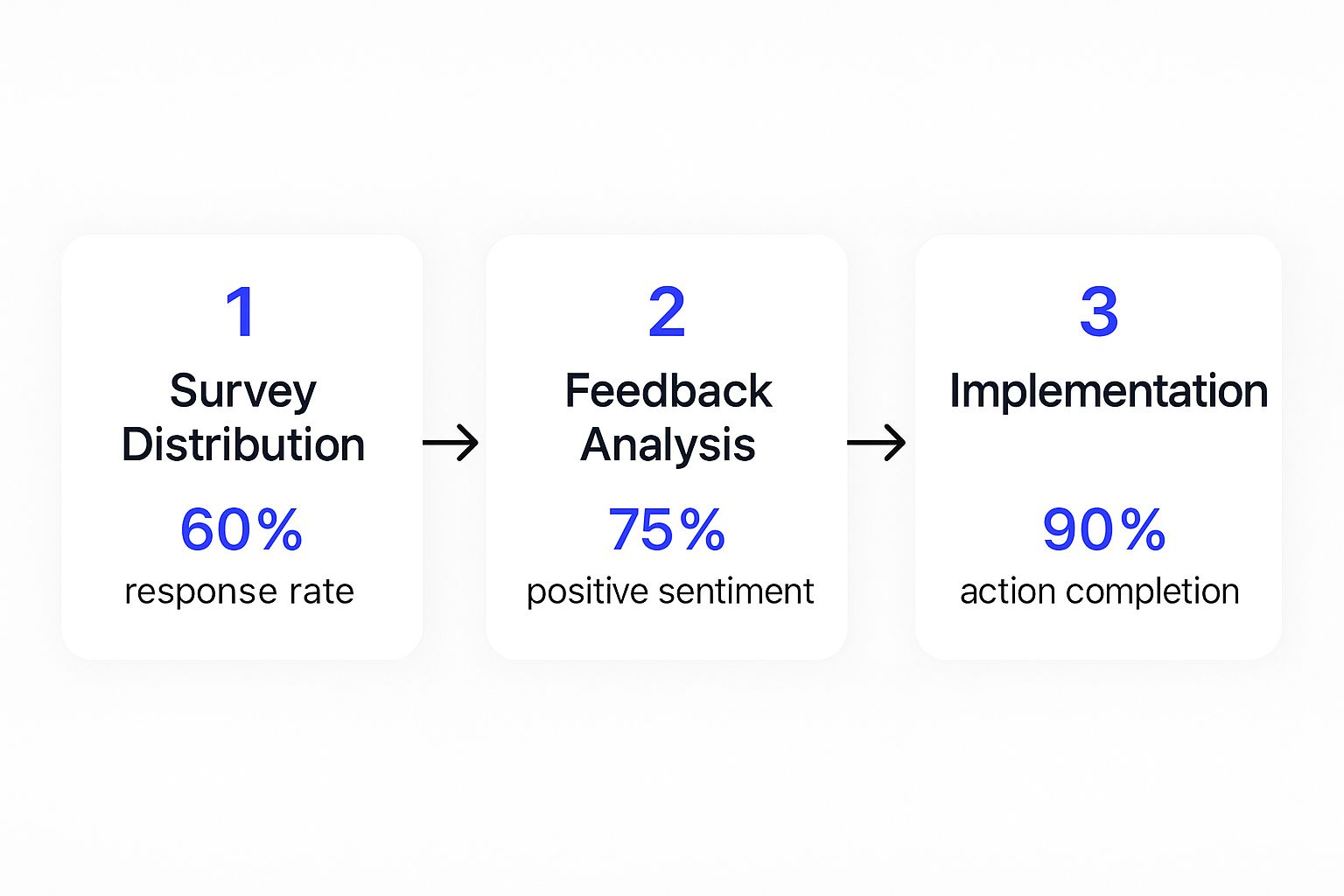
This visual drives home the importance of a strong feedback-to-action cycle. A high rate of implementation should always follow positive feedback analysis. The key isn't just to collect feedback, but to act on it systematically to improve the journey. Building the map is the first step, but the real value comes from turning those insights into tangible improvements. For more advanced strategies, our guide on customer journey optimization takes a much deeper dive.
This map will become a living document—your team's North Star. It will guide product decisions, marketing campaigns, and customer success efforts, making sure everyone is focused on what truly matters: making your customer’s journey as smooth, valuable, and enjoyable as possible.
Using AI to Automate and Personalize at Scale
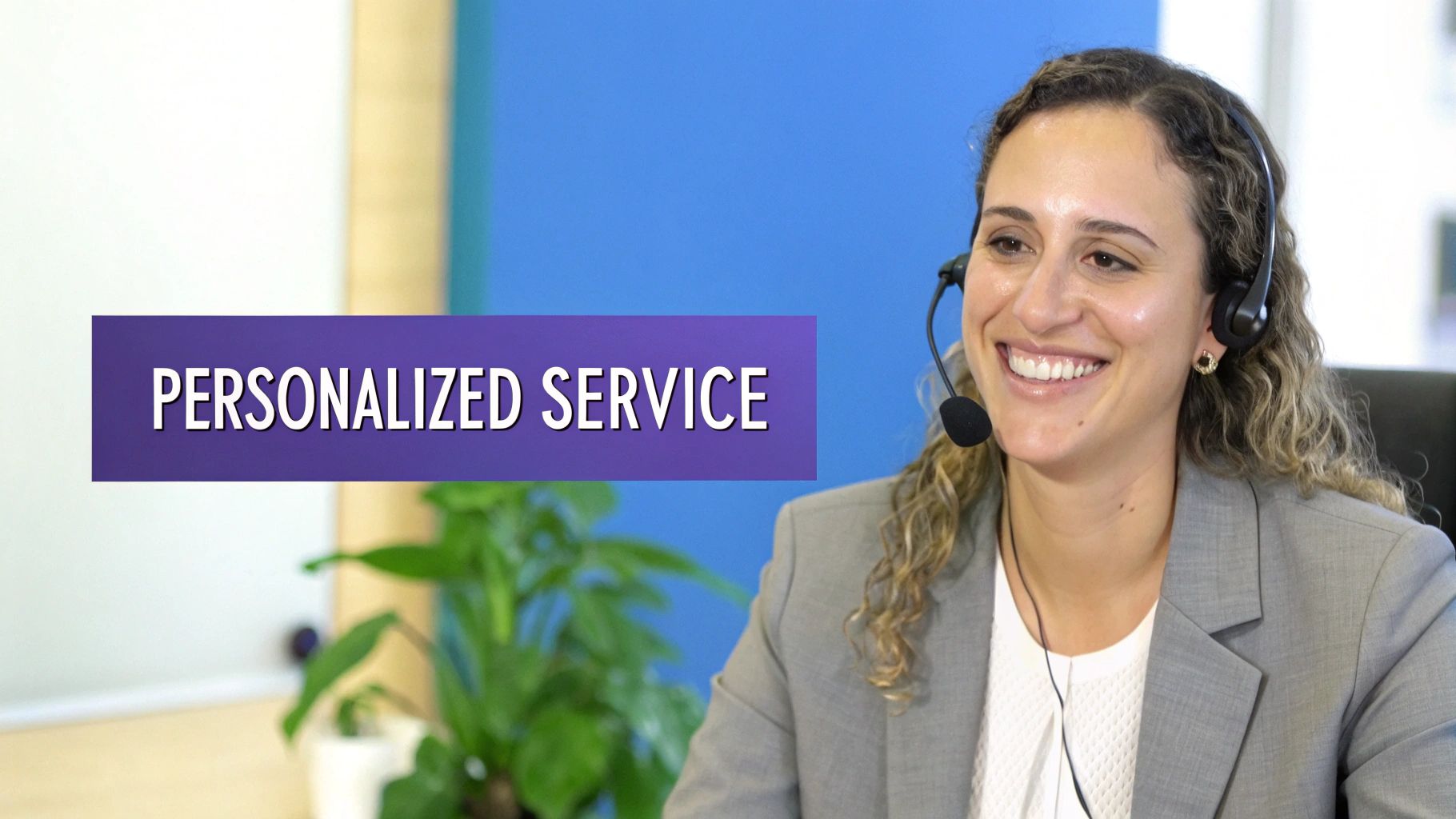
Let’s be honest, "AI" has been thrown around so much it’s almost lost its meaning. But we're not talking about some far-off, futuristic concept. We're talking about a real, hands-on tool that SaaS businesses are using right now to make their customer experience genuinely better.
The point isn't to replace your team with robots. It’s about giving them superpowers. AI can handle the mind-numbing, repetitive stuff, freeing up your people to tackle the complex, high-value problems that actually require a human brain. It’s how you deliver personal, timely help to every single user, not just a select few.
And this isn't a niche trend anymore. The shift is massive. In 2024, business AI adoption hit 72%, a huge jump from the 50% it hovered at for the past six years. Generative AI use has practically doubled, with 65% of organizations now using it regularly. If you want to dive deeper, you can explore more data on this significant shift to see how fast everyone is getting on board.
By bringing AI into your workflows, you can make sure no customer gets left behind, all while making them feel like the experience was built just for them.
Automating Support with Intelligent Chatbots
Think about your support team's daily grind. How many times do they answer "How do I reset my password?" or "Where's my invoice?" An intelligent chatbot can field these questions instantly, 24/7, without breaking a sweat.
This is a huge win for everyone. Your customers get immediate answers to their simple questions, and your support agents are freed up to solve the really tricky, nuanced issues that require their expertise. It’s the best way to prevent agent burnout while keeping response times lightning-fast.
A well-trained chatbot can be your first line of defense, handling tasks like:
- Answering FAQs: It can pull answers directly from your knowledge base to give users instant help.
- Guiding Users: It can walk someone through a basic setup process inside your app, like activating a new feature.
- Triaging Tickets: A bot can gather the initial details from a user and route the ticket to the right person or department, context included.
This level of automation creates a super-efficient support system, which is a non-negotiable part of a great customer experience today.
Tailoring Onboarding with AI-Powered Suggestions
A generic, one-size-fits-all onboarding flow is a guaranteed way to lose users before they even get started. This is where AI can completely change the game by personalizing that crucial first experience based on who the user is and what they're trying to accomplish.
Instead of force-feeding every new user the same product tour, an AI system can look at their sign-up info (like their industry or role) and what they do first in your app. From there, it can nudge them toward the features that will give them the quickest win.
Imagine a marketing manager signs up for your project management tool. Instead of showing them developer-focused integrations, an AI-driven onboarding could immediately highlight features for campaign tracking and content calendars. That's how you show value from minute one and get them to that "aha!" moment faster.
This kind of personalized guidance makes users feel understood. It helps them solve their immediate problems and makes it far more likely they’ll stick around for the long haul.
Predicting Churn with Predictive Analytics
Why wait for a customer to hit the cancel button? With AI-powered predictive analytics, you can spot the warning signs long before they decide to leave. These systems sift through mountains of user data to find the subtle patterns that scream "at-risk."
These red flags might include things like:
- A sudden drop in how often they log in.
- Decreased use of your product's most important features.
- A string of unresolved support tickets.
- Ignoring all your new feature announcements.
A platform like Surva.ai can connect this behavioral data to automated actions.

As you can see here, you can build smart, automated flows that react instantly to what your users do. By connecting a trigger like a "Cancellation Request" to an action like "Offer a Discount," you can step in at the perfect moment to save a customer.
When the system flags a high-value account, it can automatically kick off a workflow. Maybe it sends a targeted email with helpful guides. Or, it could alert their customer success manager to schedule a friendly check-in call. You can even have it offer a proactive discount through a tool like Surva.ai. This proactive approach lets you solve problems before they become reasons to churn, creating stronger and more loyal customers. It’s the perfect blend of smart tech and a much-needed human touch.
Building a Feedback Loop That Drives Improvement
Guesswork doesn't build a phenomenal customer experience. The best experiences are forged in a constant cycle of listening, understanding what you’ve heard, and then actually doing something about it. You can't truly optimize customer experience unless you know what your users are thinking and feeling at the most critical moments of their journey.
This means you need a powerful, intentional feedback loop.
Simply blasting out an annual survey and hoping for the best is a fast track to irrelevance. Effective feedback is about asking the right questions, at the right time, without ever feeling like a chore for your users.
Choosing Your Core Feedback Metrics
To build a system that actually works, you need to focus on the right things. While you could track dozens of different metrics, most successful SaaS feedback strategies are built on a bedrock of three core metrics. Each one tells a different, crucial part of the customer's story.
Customer Satisfaction (CSAT): This is your in-the-moment happiness check. It’s perfect for right after a specific interaction, like when a support ticket is closed or a customer uses a new feature for the first time. The question is dead simple: "How satisfied were you with this experience?"
Net Promoter Score (NPS): Think of this as your long-term loyalty barometer. It measures how likely a customer is to recommend your product by asking, "How likely are you to recommend our company to a friend or colleague?" This gives you a high-level pulse on your overall brand health.
Customer Effort Score (CES): This metric is all about ease. The question, "How easy was it to get your issue resolved?" helps you hunt down and eliminate friction in your product and processes. Low-effort experiences are a massive driver of customer loyalty.
These aren't just vanity metrics; they are vital benchmarks. Globally, CSAT, NPS, and CES give you a direct line into customer loyalty and satisfaction, which is always evolving. For instance, data predicts that by 2025, 94% of customers will see video support as a positive part of their service experience.
From Raw Data to Actionable Insights
Collecting feedback is just the start. The real magic happens when you transform that raw data into concrete improvements. A folder stuffed with survey responses is just noise until you analyze it for patterns and themes.
Start by tagging and categorizing every piece of feedback that comes in. Are a bunch of users complaining about a confusing interface in the reporting dashboard? Is there a spike in low CSAT scores tied to a particular support agent or process? This is where you connect the dots between what people are saying and what your team needs to do.
Don’t just count the scores. The real gold is in the comments. A user who gives you a 7/10 NPS score with a detailed comment about a specific bug is far more valuable than a silent 9/10. These qualitative nuggets are your roadmap for improvement.
Once you spot a clear trend—let’s say, a recurring complaint about your billing process—it's time to act. Assign ownership of that issue to a specific team, create a ticket in your project management system, and set a timeline for a fix. This is how feedback becomes fuel for your product roadmap and operational tweaks.
For a deeper dive into this process, check out our guide on effective feedback loop examples that shows how leading companies turn listening into action.
Closing the Loop to Build Trust
The final, and most frequently forgotten, step is to "close the loop." This simply means telling your customers that you heard them and—more importantly—that you took action. Nothing builds trust and loyalty faster than showing a user their feedback led to a real change.
This doesn't mean sending a one-to-one email for every single suggestion. It can be as simple as a "You asked, we listened" section in your next product update email, highlighting the changes made based on user feedback. To make collecting positive customer stories for this purpose even easier, you could use a dedicated testimonial generator tool.
When you close the loop, you transform a transactional feedback request into a relational conversation. You show users they are valued partners in your journey, not just numbers on a dashboard. This cycle—listening, acting, and communicating—is the engine that will continuously optimize customer experience and build a base of fiercely loyal advocates.
Weaving Customer Obsession into Your Company's DNA

Let's be honest. Even the slickest AI tools and perfectly mapped-out processes have their limits. If you want to optimize your customer experience for the long haul, it can't just be a line item in your strategy. It has to be the cultural heartbeat of your entire company.
A customer-first mindset isn't a task you check off a list. It's a shared belief system that quietly guides every single decision, from how a new feature gets built to the tone of your marketing copy.
This is where the real magic happens. It’s what separates a company that just has a support team from one where every employee, regardless of their title, feels a deep sense of ownership over the customer’s success. When CX is woven into your company's DNA, it becomes a powerful, self-sustaining engine for growth.
Tearing Down the Departmental Silos
I’ve seen it time and time again: the biggest roadblock to a great customer experience is internal fragmentation. Your customer doesn’t see your company as a collection of separate teams—marketing, sales, product, and support. They see one brand, and every single interaction, no matter how small, shapes their perception.
A disjointed internal structure will always lead to a disjointed customer experience. It’s inevitable.
Imagine a customer gets sold on a killer feature by your sales team, only to discover from support that it works completely differently than described. That single moment of disconnect shatters trust instantly. A unified, 360-degree view of the customer isn’t a nice-to-have; it’s non-negotiable.
This means you need to establish shared goals and metrics that basically force collaboration:
- A Single Source of Truth: All teams—no exceptions—should have access to the same CRM data, support tickets, and feedback history.
- Cross-Functional Huddles: Get leaders from different departments in the same room (virtual or otherwise) regularly. Their only agenda? To talk through customer feedback and journey pain points.
- Unified Goals: Stop measuring success in a vacuum. Instead of just tracking sales quotas or support response times, get everyone rallied around a shared metric like Net Promoter Score (NPS) or Customer Lifetime Value (CLV).
When everyone is rowing in the same direction, the customer journey feels seamless. The handoff from a sales rep to an onboarding specialist becomes a natural continuation, not a jarring reset where the customer has to start all over again.
Empowering Employees to Be Problem Solvers
A genuinely customer-centric culture gives every employee the power to solve problems, not just escalate them up the chain. When a team member’s first instinct is to say, "Let me find someone who can help," you’re adding friction and making the customer feel like a hot potato being passed around.
True empowerment means giving your team the authority, the tools, and the trust to make decisions on the spot.
For instance, a support agent who spots a frustrated user should be able to offer a small service credit or extend a trial without wading through three levels of bureaucratic approval. This autonomy can turn a potentially negative interaction into a moment of pure delight.
More than 50% of an experience is based on emotion. Customers become loyal because they are emotionally attached and remember how they feel when they use a product or service. A business that optimizes for an emotional connection outperforms competitors by 85% in sales growth.
That emotional connection is forged by empowered employees who can act with empathy and authority. It shows customers you trust your own team, and in turn, customers start to trust your brand.
Making CX Everyone's Job
Culture is built on the stories you tell and the heroes you celebrate. If you want customer experience to be a collective responsibility, you have to bake it into your company’s internal narrative. This isn't about slapping a mission statement on the wall; it's about making customer success a regular, visible part of company-wide communication.
Here are a few simple ways I’ve seen leading SaaS companies make this happen:
- Kick off with Customer Wins: Start your all-hands meetings by sharing a glowing review or telling a story about how someone went above and beyond for a customer.
- Crown CX Champions: Publicly recognize and reward employees from any department—engineering, finance, marketing—who make a real impact on the customer experience.
- Train with Real Feedback: When you onboard new hires, use real customer feedback, both the good and the bad. This grounds their new role in the reality of the user’s world from day one.
This constant reinforcement makes it crystal clear that CX isn't just one team's job—it's everyone's. This cultural foundation is crucial for long-term success and underpins many of the most effective customer retention strategies. When your entire culture is built on customer-centricity, you create a sustainable advantage that no competitor can easily copy.
Got Questions About SaaS CX? We've Got Answers
Jumping into customer experience optimization can feel like a lot, especially when you're juggling a dozen other priorities. Let's break down some of the most common questions SaaS teams ask when they decide to get serious about building a more customer-centric business.
Where Should We Start on a Tight Budget?
If your resources are stretched thin, don't even think about a massive, expensive overhaul. The single best thing you can do is map out your customer journey and find the moments of highest friction. From there, focus your energy on a few small, high-impact fixes.
Here are the most common (and effective) places to start:
- The Onboarding Flow: Is there one particular step where you see a huge number of new users just disappear? Fixing that single bottleneck can make a massive difference in your activation rates.
- The First Support Ticket: How do you handle that initial cry for help? A fast, empathetic, and genuinely helpful first support interaction can build an incredible amount of trust right out of the gate.
- The Cancellation Process: What happens when someone decides to leave? This isn't just a loss; it's a golden opportunity to understand why they're churning and maybe even win them back.
You don't need fancy tools. Just use simple, targeted surveys or session recordings to pinpoint one key area of pain. Solving a single, major issue is way more budget-friendly and delivers more immediate value than trying to boil the ocean.
How Can We Measure the ROI of Our CX Investments?
This is the big one. Proving the return on your CX efforts is what gets you buy-in and secures future budgets. The trick is to draw a straight line from your CX improvements to cold, hard business metrics. This isn't about fuzzy feelings; it's about real financial results.
Tracking ROI isn't just about justifying costs. It's about proving that a better customer experience is a direct driver of revenue growth. When you can show that a 10-point jump in NPS correlates with a 5% drop in churn, CX stops being a "nice-to-have" and becomes a core business strategy.
Get laser-focused on tracking these key indicators:
- Customer Retention and Churn: This is your most direct link. As your experience improves, your churn rate should go down. It's that simple.
- Customer Lifetime Value (CLV): Happy customers don't just stick around; they often spend more over their lifetime. Watch how CLV changes for cohorts who have experienced your CX improvements.
- Upsell and Cross-sell Revenue: A satisfied, engaged user is far more likely to upgrade their plan or try out a new feature you've launched.
- Net Promoter Score (NPS) and Referrals: A rising NPS is often a leading indicator of more word-of-mouth marketing—one of the most powerful and cost-effective ways to acquire new customers.
Will AI Chatbots Make Our Service Feel Impersonal?
I hear this fear a lot, but it’s usually based on an outdated view of what AI can do for customer service. The goal of AI isn't to replace your human experts; it's to give them superpowers. When done right, AI actually makes your service more personal and efficient, not less.
Think of it this way: AI is brilliant at handling the repetitive, high-volume, low-complexity questions that tie up your team. It can offer instant, 24/7 answers to routine queries, freeing up your human agents to focus on the nuanced, high-empathy problems where they can truly make a difference.
A well-designed system makes the handoff seamless. When a chatbot hits a wall, it should instantly escalate the conversation to a human agent with the entire context of the interaction. This means the customer never has to repeat themselves, which leads to a faster and far more satisfying resolution. It's the perfect partnership between machine efficiency and the human touch.
Ready to turn customer feedback into your biggest growth driver? Surva.ai gives you the tools to understand why users churn, collect powerful social proof, and automate personalized experiences that build loyalty. Start optimizing your SaaS customer experience today with Surva.ai.

